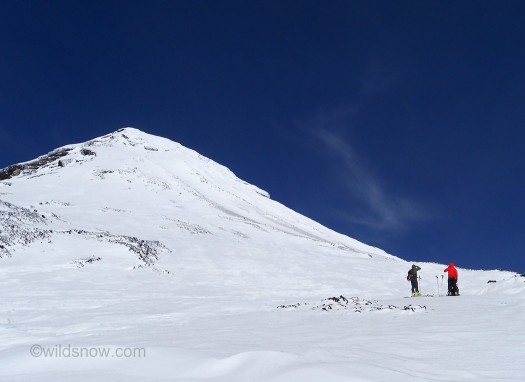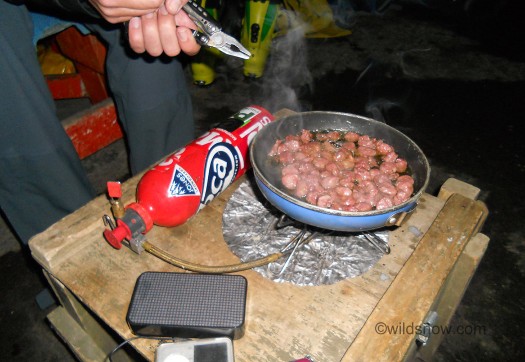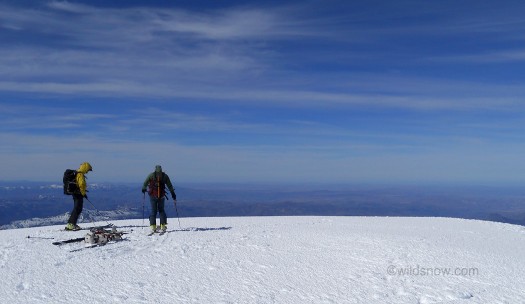The short Southern Hemisphere winter is transitioning into spring, with good weather, less wind, and less snow. That means one thing: volcanoes!
Regretfully, we packed our bags and left Bariloche. Not only home to some of the best skiing of our trip so far, Bariloche has cheap steak and delicious, even cheaper pastries, and it’s a beautiful little mountain town.
We made our way from Bariloche to Junin de los Andes, a town a bit further north. We checked into an inexpensive hotel and went off in search of our last Argentine pastries. Summer flyfishing is apparently the main tourist business here, and the town was quite dead, a welcome change from the lively, but very touristy Bariloche. We found delicious pastries, empanadas, and pizza, and feasted in preparation for the next day.
We woke early to catch the 6 am bus to Pucon, which passes the Lanin trailhead on the way, right on the Chile-Argentina border. While waiting for the bus, we smelled bread cooking and found a bakery that opened minutes before the bus left. I guess these would be our last Argentine pastries! Munching of fresh bread and well stocked with cookies, we left for Lanin.
There was nothing to be seen but clouds when we arrived. We checked in with the park ranger, and he allowed us to store our baggage in the ranger station for the duration of the climb. I’d heard that you need to rent a VHF radio for the climb, and that they might require you to have a guide. The park ranger told us “just be careful,” and let us head out.
After a bit of packing and reorganizing, we set off up the trail, toward a refugio located partway up. Once again the trail was nicely maintained, undoubtedly intended for the hordes of the summer climbing season. We didn’t see a soul. Along the way we even passed a small “andinista” graveyard. Toward the end of the trail we were able to start skinning, and after what seemed like quite a while with our heavy packs, we made it to the refugio.
A far cry from the spacious Refugio Otto Meiling on Tronador, or the even nicer Refugio Frey, this refugio consisted of a bright orange tube. Composed of some sort of hard foamy material, with a few tiny translucent windows, it sits on a concrete slab. “Refugio RIM Militar Argentina” was written on the side, apparently built by the Argentine military, for some unknown reason. Still, it’s much better than a tent (though we continue to wonder if it was BPA free).
After our forced alpine start to catch the only bus, we had gotten to the refugio early, but not early enough to get to the top, so we spent the next hours drinking tea and experimenting with Whisperlight polenta cakes.
The next morning I slept through my feeble watch alarm. No matter, we had the whole day to get to the summit but if we wanted to catch the bus we had to get back to the trailhead by noon. The night before I had been feeling a little sick, and this morning it was full force. I woke with a sore throat, and before we finished getting ready, I had a pounding headache and was puking outside the refugio. There was a good chance this was a once in a lifetime opportunity, so I decided to head for the top despite my condition.
Quite a contrast to the day before, there wasn’t a cloud in the sky as we started skinning. The windswept snow was icy, and I soon had to switch to booting. Sanders kept using his ski crampons. I was a bit jealous, darn 50 lb baggage limits!
The cone of the volcano rose 4,000 feet above us, but without anything to show scale it looked a lot closer. The distance became apparent from our slow progress, or maybe it was just my headache. Eventually we boarded Lanin airlines, and rose far above every other peak we could see. As we got close to the summit, we stopped a few times to peer down the eastern face, which holds several big, steep couliors. Alas, this Atacama-dry South American season meant many of the chutes were blocked by big cliffs, but a few went all the way through, as far as we could tell.
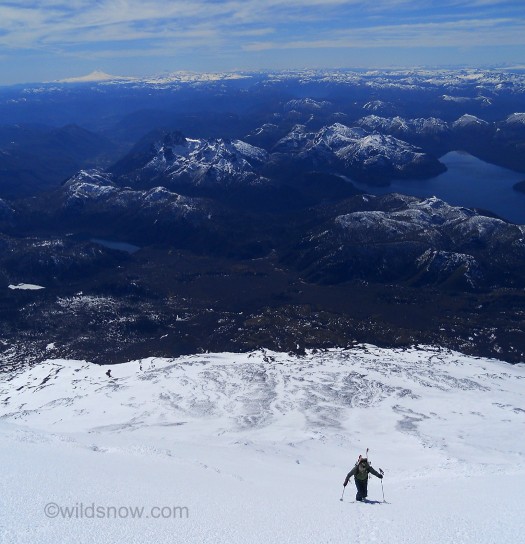
Getting closer to the summit of Lanin. The lower mountains and lakes stretched below us. This is looking north, approximately along the Chile-Argentina border.
The wind picked up as we crested the summit. “Welcome to the top of Patagonia!”, the sign at the ranger station the day before had said. It certainly seemed like it. With clear skies, we could see for miles. On the Argentinian side there was hardly any snow, just some scattered mountains and the famous “pampas” stretching into the distance. The Chilean side was snowier and greener, with a blanket of clouds in the valleys.
We made turns on snow that passed for a sort of corn, until we reached the entrance to one of the northeastern couloirs. Skyler dropped in first, checked out the snow, and found a way through the cliffs. I had hoped for powder, but instead we found wind crusts of varying thickness, and some hard snow. Booting out seemed like a worse option, so we skied it anyways. Even with bad snow, you can’t complain about a 4,000 foot coulior off a 12,000 foot volcano.
At the base of the chute, we roped up for a short traverse across a glacier to get back to our ascent route, and then skied down to the refugio. The snow got better as we got lower, and after packing up our overnight gear we enjoyed sloppy corn turns down to the trail. The trail went quick, but we still got to the trailhead at 7:30, shortly before the border closed. As we reached the ranger station, Nicholas, one of the rangers, came out, and excitedly showed us his camera. Evidently he had been watching us ski, and had taken some pictures. It’s not often you get to see pictures of you skiing something from across the valley. I was astonished at how tiny we looked. After chatting with the ranger for a bit, he offered to let us stay in a bunkroom in the back of the ranger station, and even use the propane stove. Stoked on the unexpected free accommodations, we cooked our remaining bit of pasta and quickly passed out.
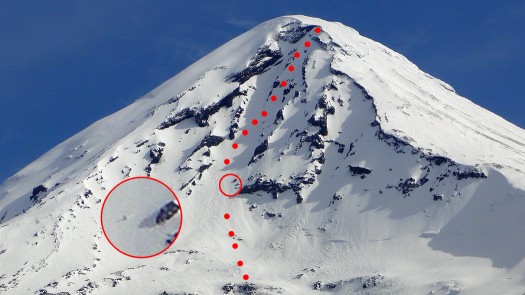
While we were skiing down a coulior on the steeper Northeast face of Lanin, one of the park rangers was taking some pictures. Our route is delineated in red, while the large red circle zooms in on a tiny skier, in the spot shown by the small red circle.
I feel incredibly lucky to keep hitting the weather windows on these volcanoes. Almost every one so far, with the exception of Villarica, we’ve done the approach in bad weather, summited on a bluebird day, and the day after is cloudy again. I guess that’s one advantage of a dry winter: more sun!
Louie Dawson earned his Bachelor Degree in Industrial Design from Western Washington University in 2014. When he’s not skiing Mount Baker or somewhere equally as snowy, he’s thinking about new products to make ski mountaineering more fun and safe.

